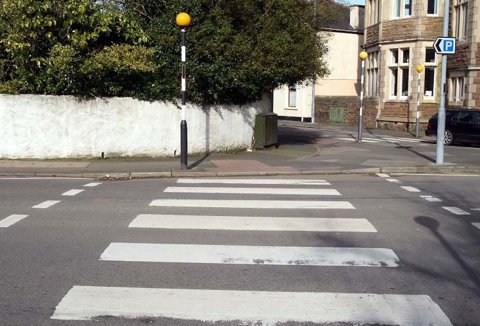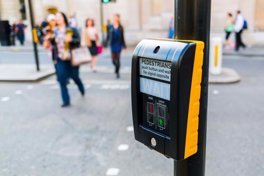Other Significant Changes to the Highway Code
Priorities for pedestrians at crossings
Previously, drivers, horse riders and cyclists had priority over pedestrians when they approached a crossing; they’d only need to give way to a pedestrian if the pedestrian had already started crossing the road.
With the new Highway Code rules, drivers, horse riders and cyclists must now give way to pedestrians who are either crossing the road at a crossing or waiting to cross it.
Cyclists have also been reminded that pavements are for pedestrians only, and that pedestrians are allowed to use cycle lanes unless there’s a nearby road sign that says they can’t.
Drivers to give way to cyclists at junctions
The new Highway Code also now states that at junctions or when changing direction or lanes, drivers must not cut across a cyclist or a horse rider that is going straight on.
Drivers must now stop and wait for a safe gap when cyclists or horse riders are:
- Approaching, passing or moving away from a junction
- Moving past or waiting alongside still or slow-moving traffic
- Travelling on a roundabout
Safe distances for cyclists passing parked vehicles
To stop cyclists colliding with open vehicle doors, they’re now being advised to leave at least a door’s width - or one metre - when passing a parked vehicle.
Parked motorists are also being told to perform the "Dutch Reach" when opening their vehicle door.
The Dutch Reach means a motorist should open their door using the hand on the opposite side to the door they’re opening. For example, they would use their left hand to open a door on their right side. This manoeuvre should make them turn their head, look over their shoulder and check their blind spot.
New road positioning for cyclists and horse riders
The updated Highway Code states that cyclists and horse riders are now able to ride in the centre of their lane when they’re approaching a junction or when they’re on a narrow road where an overtaking vehicle could cause them harm.
When a driver wishes to overtake a cyclist, they must do so safely while traveling at 30mph and giving the cyclist at least 1.5 metres. Essentially, passing a cyclist will be similar to overtaking a car, in terms of how much room you should provide.
Single file rule scrapped for cyclists
Previously, cyclists were told they should avoid riding two abreast on narrow or busy roads.
With the new changes, cyclists should now ride two abreast because it’s safer for them to do so, especially if they’re in a large group of cyclists, or if they’re accompanying children or less-experienced riders.
Using Electric Vehicle Charging Points
The latest update for the Highway Code includes guidance about what to do when using electric vehicle charging points to make sure that everyone is safe.
When you use an EV charging point, you should park close to the charge point to avoid creating trip hazards with the cables. If possible, you should display a warning sign, so that any cables and hazards are made clear. When you’ve finished using the EV charging point, always make sure that you return the cables and connectors neatly, so that there’s no obstacle and dangers are minimised.
Updated Mobile Phone Rule
The already existing mobile phone rule has been updated in light of smartphones. Back in 2003, the original rule didn’t reflect that smartphones can be used for much more than just simply making calls.
The Highway Code have updated and added more restrictions on mobile phone use to reflect the latest smartphones and how people use them. It now includes using music apps, taking photos or videos, and playing games. Even when the car is stationary, you’re not allowed to use it.
But it’s important to clarify here that answering hands-free calls via Bluetooth or a wired connection in your car is acceptable, as long as your phone is in a secured place that isn’t your hands or lap.
Cyclists and Horse Riders on a Roundabout
This newly updated Highway Code gives cyclists and horse riders priority when they are using roundabouts. If you’re driving a car or riding a motorcycle, you should never attempt to overtake a cyclist or horse rider on a roundabout. You should also allow cyclists and horse riders to move as they travel around the roundabout.
Self-Driving Vehicles
In July 2022, the Government amended The Highway Code further by introducing a section about self-driving vehicles. The new rule relating to self-driving vehicles indicates that watching in-built ‘infotainment’ is allowed and that the driver may divert their attention away from the road.
But the new rule clarifies that the driver must not do anything that is considered illegal, such as using a mobile phone. Any other rule is still in place, and you must act accordingly, as if you’re not traveling in a self-driving vehicle for activities like these.
There is one exception to this rule, which allows the driver to call 999 or to process a payment via their phone using contactless payment terminals. If you’re ever unsure about the rules, we recommend reading The Highway Code and seeking advice on your interpretations of the law.
What to Do After a Road Traffic Accident
While The Highway Code isn’t legislation and some rules aren’t legally enforceable, they offer good guidance on what you should and shouldn’t be doing while using the roads. The introduction of a hierarchy of road users should help provide assistance when it comes to traffic accident claims.
But it still remains to be seen whether or not The Highway Code will impact the overall road safety.
Contact the Road Traffic Accident Team if you’ve been involved in a road traffic accident that happened because someone failed to follow the Highway Code.
We’ve worked with clients whose lives have been devastated by death and serious injuries on our roads, due to entirely avoidable collisions.
Get in touch to see how we can help. We’ll offer you a free consultation to discuss your case and an expert solicitor will provide legal advice on your options. If we can take your case on, we’ll keep you informed every step of the way and work closely with you to secure the best possible outcome.









